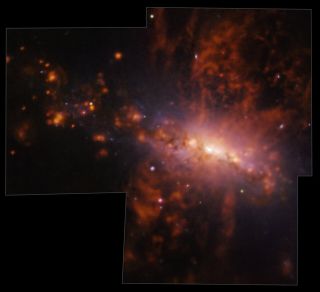Deep within the heart of the spiral galaxy NGC 4383, a mesmerizing dance unfolds. A colossal fountain of gas, spanning a staggering 20,000 light-years, erupts from the galaxy’s core, spewing forth material equivalent to a mind-boggling 50 million suns.
This isn’t just a mesmerizing display; it’s a crucial symphony in the grand opus of galactic evolution, a complex interplay between the birth and death of stars.
Astronomers Witness a Galactic Outflow in Exquisite Detail
Using the European Southern Observatory’s Very Large Telescope (VLT) and its powerful MUSE instrument, a team of researchers has conducted a masterclass in celestial observation. The data they’ve captured reveals a galactic geyser in unprecedented detail. It’s a high-velocity ballet of gas, hurtling outward at speeds exceeding 450 times the velocity of a fighter jet. This turbulent expulsion of gas is more than just a celestial tantrum; it’s a vital chapter in the ongoing story of galactic evolution, a story written not just in the stars themselves, but in the vast canvas of intergalactic space.

Gas leaves the galaxy NGC 4383’s core at extremely high rates, driving its evolution. (Photo courtesy of A. Watts et al. and ESO)
Fueling the Fires of Star Formation: From Stellar Winds to Supernovae
The gas fountain spewing from NGC 4383 is not merely hydrogen, the universe’s most abundant element. The VLT’s MUSE instrument has revealed the presence of oxygen, nitrogen, sulfur, and a rich tapestry of other chemical elements – the very ingredients for future stars and planetary systems. As this gas drifts into the vast intergalactic space, it becomes a treasure trove of raw materials, waiting to be sculpted into new celestial creations. Imagine a cosmic chef, meticulously gathering ingredients for the next generation of stars and planets. The galactic outflow from NGC 4383 is not just a messy expulsion; it’s a carefully curated selection of elements destined to form the building blocks of future celestial wonders.
The Engine Room of the Outflow: A Stellar Drama
The researchers believe the colossal gas outflow is fueled by the frenetic activity at NGC 4383’s core. This region is currently experiencing a stellar coming-of-age party, a burst of star formation churning out massive stars that burn brightly and intensely. These stellar giants unleash powerful stellar winds that push against the surrounding gas, contributing to the outward flow. Additionally, the inevitable supernovae that mark the explosive deaths of these stars deliver a final, mighty shove, further propelling the gas outwards. It’s a dramatic stellar performance, a final act that leaves a lasting legacy on the galaxy and the cosmos at large.
A Double-Edged Sword: The Impact of Outflows on Stellar Generations
While galactic outflows like the one seen in NGC 4383 seed the intergalactic medium with the ingredients for future star formation, they also have a downside. The relentless expulsion of gas depletes the galaxy’s own reservoir of star-forming material. Over time, this can lead to a decline in star birth within the galaxy itself. It’s a zero-sum game; the riches NGC 4383 bestows upon the intergalactic medium come at a cost to its own future generations of stars.
A Fountain of Knowledge: Unveiling the Mysteries of Star Formation Across the Cosmos
The observations of NGC 4383 represent the first findings of the MAUVE (MUSE and ALMA Unveiling the Virgo Environment) survey. This ongoing project aims to shed light on the complex interplay between gas outflows and star formation across a wide range of galaxies. The detailed data from NGC 4383 provides a valuable case study, offering astronomers a deeper understanding of how these galactic outflows shape the destinies of galaxies and the ongoing cycle of star birth across the cosmos.
As we continue to unravel the secrets of these celestial fountains, we gain a deeper appreciation for the dynamic and interconnected nature of our universe. The seemingly chaotic eruption from NGC 4383 is not just a spectacle; it’s a testament to the ongoing process of creation and evolution that governs the cosmos, a story written in the birth pangs of stars and the explosive farewells of stellar giants.



















